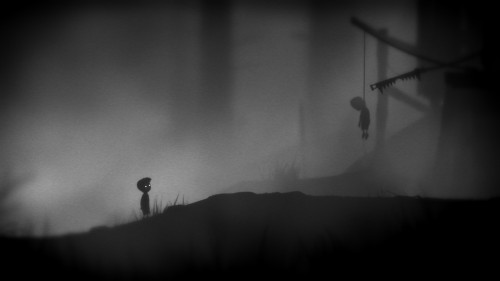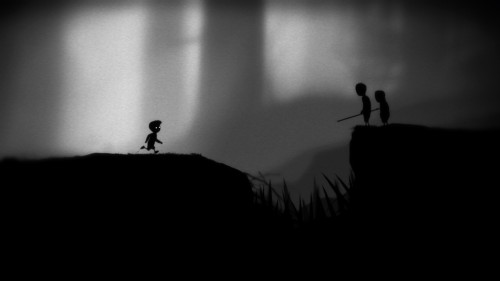I had a tough time playing Limbo.
It wasn’t due to deficient game playing skills on my part or any bugs or faults with the game’s programming. No, I had a tough time playing through Limbo because I was genuinely unsettled by the hauntingly melancholy game atmosphere with its grainy black and white visuals and sparse, yet disturbing ambient sounds and audio cues.
You may think I’m talking about a new survival horror game, but I’m not. Limbo is a 2D platforming puzzle game.
“How is this possible?” you may ask. Just watch this short trailer:
I found it appropriate that the protagonist of the game is a young boy because a lot of what disturbed me in Limbo scared me as a child. I have a ghastly fear of spiders, insects, and man eating plants that crystallized in my youth somewhere between the piranha plants in Super Mario Bros. and the insects in Daikatana.
Death in Limbo is also an infinitely more powerful on screen event because it is happening to a little boy. My first death happened via running into a bear trap on the ground. The trap chomped my boy into an aerial concerto of bloody body parts which then collapsed limply to the ground. It quickly became obvious that I wasn’t going to be playing Rayman.
One particular scene early in the game has you walk by a white butterfly on the ground who flies off towards a tree that is clearly harboring a giant black spider lurking in the branches above. I must have spent a good five minutes sitting in my chair, paralyzed. I saw no obvious route around the tree, yet there was no fucking way I wanted to walk under three giant spider legs. Given that the game had established a precedent for grisly deaths by that point, I especially did not want to see what this spider was going to do to the little boy.
Eventually, I excruciatingly faced my fears and found a way past the spider situation. The game may “just” be in black and white, but the realistic animations of the boy and the world combine with the game’s desolate atmosphere to create a completely immersive experience.
Who are you? Why are you here? Where are you?
These are questions Danish developer Playdead want you to wonder about while playing through Limbo. And they did, in fact, linger in the back of my mind throughout the game’s first half, especially with the appearance of other humanoids (dead and alive). However, as the game progressed, I found myself caring less and less about these things and just focusing on what my next destination was and how to reach it. In other words, gameplay became the driving motivational force, not the search for greater meaning in the story.
A word about the gameplay: much of it is based on a “die first, figure out why after you respawn” paradigm. During your first playthrough you should expect to die often and die unexpectedly. This may sound like a frustrating nightmare, but for the most part isn’t, because there are bountiful checkpoints that place you close to your place of death. However, there are a couple of places in the game where I repeatedly yelled “Come on!” at my screen because I could not discern a certain goal and the death checkpoint forced me to play through a previous section before I could take a crack at it again.
Comparisons to Jonathan Blow’s breakthrough “indie” game, Braid, are bound to pop up due to both games belonging to a similar genre. I’ll take a shot at declaring a “winner” by saying that Limbo doesn’t quite reach Braid from both a gameplay and narrative standpoint. Overall, Limbo’s puzzles aren’t as elegantly designed as Braid’s. Many of the more difficult ones require precision timing and button pressing dexterity to solve problems, rather than imaginative and cereberal solutions. That’s not to say Limbo is poorly designed – there are some wonderfully devious puzzles that give a real sense of fulfillment once you figure them out. It just doesn’t feel as naturally rewarding as Braid did.
Braid’s narrative benefited from the use of prose in its introductory and ending sequences. These words really tugged at me emotionally and provided context for the story it was trying to get across. Limbo, on the other hand, does not have one word of text within the game. It relies solely on its greatest strength, its visual and audio atmosphere, to convey its message. Limbo starts off strong in this regard, but the sense of uneasy wonderment slowly peters out until the ending is reached. It’s an ending which I feel tries to capture the same level of existential meaningfulness as Braid, but ultimately falls short.
Having said all of this, Limbo still comes highly recommended if you enjoy playing puzzle platformers and/or delight in immersive and unique art styles. It’s unquestionably the best downloadable game I have played in 2010 thus far. Just be warned if you have qualms about viewing gruesome child deaths or have fear of giant insects.
One final tip: Don’t read the game’s description on Xbox Live Marketplace if you can avoid doing so. I think the game’s ultimate meaning is far more interesting and thought provoking were I not to have read the short premise on the description. For me, it was a throwaway fact that served to only narrow the possibilities of the game’s conclusion.
Limbo costs 1200 Microsoft Points ($15) as a downloadable title from the Xbox Live Marketplace. There is a trial version that encompasses the first two game chapters.
[cincopa 10681581]



